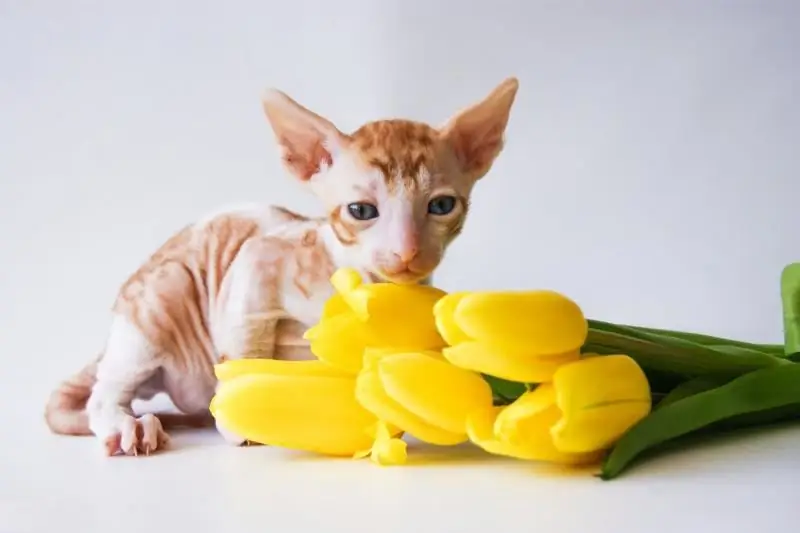
Table of contents:
- Cornish Rex is a fun pet with a playful personality
- The history of the emergence of the Cornish Rex cat breed
- Features of Cornish
- The nature of the breed
- Cornish health
- Recommendations for choosing a kitten
- Cornish Rex care rules
- Breeding features
- Video: about the breed of cats Cornish Rex
- Owner reviews
- Author Bailey Albertson [email protected].
- Public 2024-01-17 22:26.
- Last modified 2025-06-01 07:32.
Cornish Rex is a fun pet with a playful personality

Among pedigree cats, there are many unusual ones. For example, the Cornish Rex. Their unique character and intelligence will surprise any animal lover. This breed is quite young, as it was bred only recently. But during this time, she has gained great popularity among connoisseurs of cats.
Content
- 1 The history of the emergence of the breed of cats Cornish Rex
-
2 Features of Cornish
- 2.1 Photo gallery: Cornish Rex colors
- 2.2 Photo gallery: Rex species
-
2.3 Table: differences between Cornish and Devon Rex
2.3.1 Video: differences between Cornish and Devonian
-
3 The nature of the breed
3.1 Video: Cornish Rex playing
- 4 Cornish health
- 5 Recommendations for choosing a kitten
-
6 Rules for caring for a Cornish Rex
- 6.1 Video: how to bathe a Cornish Rex
-
6.2 Nutrition
- 6.2.1 Finished feed
- 6.2.2 Natural products
-
7 Breeding features
7.1 Castration and sterilization
- 8 Video: about the breed of cats Cornish Rex
- 9 Owner reviews
The history of the emergence of the Cornish Rex cat breed
The progenitor of this breed was found in 1950 in England, in the city of Cornwall. Nina Ennismore saw in the baby more than a simple purr. It was decided to call it Calibunker. Observing the pet, the owner discovered in him the makings of a new breed. When Kalibunker grew up, she decided to bring the already mature cat with his mother, and then with other cats. As a result, cats of this breed appeared with both curly and even hair.
In 1957, Nina published photographs of her unusual pets in Life magazine. As a result, her kittens were bought by felinologists almost immediately. And in 1962 these cats gained popularity and a new name - "Cornish Rex", or "Cornish Rex". In 1957, they began to breed in the United States. The breed was officially recognized in 1967 in England, at the same time a standard was developed. And by 1983, all feline associations recognized the Cornish Rex.
Subsequently, there were two directions of development of the breed: European and American. There are two new intra-breed species of Rex:
-
the American look has a thinner and more elegant physique, as well as a graceful gait; many breeders and lovers of Cornishes compare them with porcelain figurines, the ears of these cats are larger than those of the European species, and the limbs are longer;

American Cornish Rex American Cornish Rexes are more elegant than European ones
-
European species have retained the attribute of the first Rex - a stocky body and not so big ears.

European Cornish Rex The European Cornish Rex has a stronger-looking body
But they still have one thing in common - the curls on the wool and a unique kind and affectionate character
Features of Cornish
Cornish Rexes are medium sized cats. Their height at the withers is 23-27 cm. At first glance, they may seem very fragile, but in fact their muscles are well developed. The head is small, egg-shaped. The ears and eyes are large. The tail is long and thin.
The calling card of this breed is wavy and soft wool, thanks to which they look like a sheared ram. The outer and outer hair are absent. The curls on the coat are well defined. Cornish Rexes can be of any color.
Photo gallery: Cornish Rex colors
-

Black cornish rex -
Black Cornish Rexes have a very mysterious look
-

Red cornish rex - The standard allows any color of Cornish
-

Tricolor Cornish Rex - The tricolor color of the roots is also common.
-

White Cornish Rex kitten - White roots often have blue eyes.
-

Cornish Rex against the blue sky - A feature of the Cornish Rex breed is an unusual curly coat for cats.
Adult cats can weigh up to 4.5 kg and cats up to 3 kg.
There are several varieties of Rex. The most common are:
- cornish rex;
- devon rex;
- herman rex;
- selkirk rex.
Photo gallery: Rex species
-

Herman Rex -
Herman Rex has a very strong physique
-

Devon rex - Devon Rex and Cornish are often confused, although they have a number of significant differences.
-

Selkirk Rex - Selkirk Rex cats look like curly Persians
Most often, the Cornish is confused with the Devon Rex. But they have a number of very significant differences.
Table: differences between Cornish and Devon Rex
| Cornish Rex | Devon rex | |
| Head shape | Elongated, ovoid | Heart shaped |
| Nose | Straight | With a clear transition to the forehead |
| Ears | Quite large, set high | Very large, low set |
| Wool | Wavy curls directed towards the skin | Curls do not have a clear directionality, the guard hair differs from the undercoat in length and thickness |

Devon Rex (left) is quite different from Cornish Rex (right)
Video: differences between Cornish and Devonian
youtube.com/watch?v=KNxWeduW2dg
The nature of the breed
Cornish cats are considered one of the most intelligent cats, as they:
- do not mark the house as their territory;
- do not try to bite or hurt the owner;
- do not jump on furniture in search of tasty things;
- have a kind and too trusting nature.
All Cornish Rex kittens are playful and funny. And representatives of this breed remain so forever. They are very intelligent and trainable.
Corniches are very acrobatic. My curly-haired pet simply loved to climb the tallest cabinet in the room and jump from there onto the bed. Each time I wondered how she managed to get there.
Their amazing nature makes these cats ideal partners for their owner:
- they are very obedient;
- have high intelligence;
- understand how to behave if the owner is out of sorts;
- they have absolutely no aggressiveness;
- get along well with children and other pets;
- devoted to their master;
- loyal to strangers;
- love communication.
But this breed also has its drawbacks:
- they are very curious;
- have a high price;
- eat a lot;
- can't stand loneliness;
- quite noisy;
- require a lot of attention.
Cornish people don't like noisy companies. My cat often hid when drunk or loud guests came.
Video: Cornish Rex playing
Cornish health
Representatives of this breed most often fall ill with the following diseases:
-
hereditary hypothyroidism (low thyroid hormone levels), treated with thyroid hormone administration, signs:
- change in appetite;
- deterioration of health (apathy, inactivity);
- deterioration of the skin and coat;
- the appearance of overweight.
-
dermatomycosis (a fungal skin disease that leads to hair loss), signs of this disease are:
- loss of hair;
- the appearance of gray scales in the head, paws and ears.
Corniche is very sensitive to temperature or climate change, so it is better not to travel with cats of this breed. Their average life expectancy is 14-15 years, but with proper physical activity, frequent walks and good nutrition, the Cornish Rex can live up to 20 years.
Recommendations for choosing a kitten
It is not recommended to buy pets at the "bird market" or in pet stores, as there is a high risk that you will be sold a sick or fake Cornish Rex. It is better to take an animal from nurseries, breeders or friends.
It is necessary to take a kitten no earlier than 2.5 months from the moment of birth, so that by the day of transfer to a new family, he has grown up and received the necessary lessons from his mother. Good breeders have kittens by this time already able to go to the toilet, accustomed to food and vaccinated against diseases. But the price of these sellers is often very high.
It is very difficult to determine the purebredness of Cornish kittens, since the main feature of this breed - curls on the wool - are usually absent in kittens at the time of purchase. They are born with a wavy coat, which becomes straight by the end of the first week after birth. Kittens acquire their curly hair only by 6-8 months. That is why it is so important to buy a kitten only from proven catteries with a good reputation.

Cornish Rex kittens lose their curliness about a week after birth
Cornish Rex and Devon Rex kittens are very similar to each other. Devons are also born curly and lose this feature by about two months of age. In order not to confuse Cornish Rex kittens with babies of other breeds, you need to focus on other signs that have already been described above: the shape of the head, the size of the ears, etc.

Cornish and Devon Rex have very different head shapes.
When buying a kitten, the breeder must give the new owner the original documents on the baby's pedigree (certificate of origin and permission to obtain a pedigree), a veterinary passport with the date and names of all vaccinations affixed
The cost of cornish depends on their purpose:
- breed kittens, which are used for further breeding, can be bought for 31 thousand rubles;
- pet-class animals, which can only be pets and are subject to sterilization, can be bought for 25 thousand rubles;
- show-class kittens that can participate in exhibitions cost about 50 thousand rubles.
Kittens of this breed can be bought in the following nurseries:
- DEJ-LAXI (Moscow);
- Cornelita (Moscow);
- Island of legends Ca (St. Petersburg);
- Jimdo (Kiev);
- MonAmour Elf (Kiev);
- Arbor vitae (Minsk).
When choosing the sex of an animal, you should decide on your preferences. Cats are cleaner and less active than males. They tend to be more expensive than males. But cats are very active and, oddly enough, more affectionate than females. They are also more curious.
Immediately at the time of purchase, you need to examine your future pet for the presence of diseases or defects. To make sure that the animal is healthy, you must:
- make sure that he has no discharge from the nose and eyes;
- examine the auricles - they must be clean;
- pay attention to the fur: it should not be pale;
- make sure that there are no insects (fleas, ticks) in the hair of the animal;
- examine the skin for peeling, scratches, bumps and swelling;
- feel the stomach: it should not be very large and soft;
- stroking the baby: when stroking the abdomen, the animal should not show dissatisfaction;
- look under the tail of the kitten: there should be no redness, cracks and discharge on the anus.
Cornish Rex care rules
Cornish hair requires attention. When combing, in order not to spoil the hairs and leave the characteristic curls intact, you only need to use brushes made of natural bristles. Do not use combs or massage brushes with metal teeth: they can damage the delicate skin of the animal. These cats should be brushed no more than 2 times a week.
Cornish Rexes are bathed as they get dirty. It is not recommended to wash the animal more often than once every 3-4 months. For bathing, you need to use shampoos that are intended for washing short-haired cats. For example, Ms. Kiss # 1 or BioVax. It is necessary to lather a cat of this breed only in the direction of hair growth. After washing, the hair of the cornish must be blotted with a soft towel. You cannot rub them at the same time. Drying with a hairdryer is not recommended.
Caring for the eyes of Cornish is quite simple and does not differ much from caring for the eyes of other purrs. They should be cleaned from secretions as they become dirty, about 1 time per week. To do this, you can use a cotton pad moistened with boiled water.
Rexes have very large ears and can accumulate large amounts of sulfur and dirt. Therefore, it is recommended to clean them with a moistened cotton swab at least once a week. But you just need to do this very carefully so as not to damage the eardrum and hurt the pet.
Clipping the claws of this breed is optional. But so that the cat does not accidentally scratch others, you need to do this procedure at least once a month.
To prevent the appearance of an unpleasant odor from the mouth, you need to clean your pet's teeth several times a month (on average every 7-10 days) with special toothbrushes for animals or ordinary small brushes for children.
Video: how to bathe a Cornish Rex
Cornish Rexes can go to the toilet in absolutely any container. The main thing is that it fits your pet in size. The filler also doesn't matter. These animals are not picky at all.
Food
Adult roots should be fed 2 times a day. Kittens up to 3 months are fed 5 times a day. When they reach six months of age, the frequency of feeding is reduced to 3-4 times a day. And at the age of 10-12 months, kittens eat 2-3 times a day.
You can feed cats both with ready-made premium or super-premium class food (dry, wet or canned), and natural products.
Finished feed
Among the manufacturers of ready-made feeds are:
- ACANA;
- PRO PLAN;
- BOSH;
- ROYAL CANIN;
- HILLS;
- EUKANUBA;
- EAGLE PACK;
- IAMS;
- NUTRO CHOICE;
- PRO NATURE;
- INNOVA;
- CHIKEN SOUP;
- ORIJEN.
It is not recommended to feed this breed with economy class food, as this can lead to serious health problems
Natural products
When deciding to feed your pet with natural food, you need to remember that his diet must include such products as:
- boiled lean meat (beef, turkey, chicken), liver, heart;
- dairy products;
- unsalted cheeses;
- raw or cooked vegetables;
- egg yolk;
- cereals (oatmeal, rice, buckwheat).
It is categorically impossible to include the following foods in the cornish diet:
- bones;
- fat meat;
- fatty, spicy, salty, smoked products, including sausages and canned food for people;
- sugar, chocolate, sweets, cakes and everything sweet;
- potatoes;
- legumes (soybeans, peas, beans);
- salt, spices.
Breeding features
Puberty for Cornish Rex occurs at about 7-9 months. But it is still impossible to plan mating at such a young age. It is allowed to knit roots only when they reach the age of one year.
Pregnancy and childbirth in cats of this breed is mostly easy. Healthy and beautiful kittens are often born. There are no special recommendations for mating these animals. But there is one very important rule: it is forbidden to mate Cornish Rex with other breeds of cats.

Cornish Rex kittens look like plush toys
Castration and sterilization
Most people believe that neutering is an operation that can only be performed on males and neutering in cats. In fact, this is not the case. These procedures can apply to both genders, they differ as follows:
- castration involves the removal of the testes in cats and the ovaries and uterus in cats;
- sterilization is only a ligation of the fallopian tubes in cats and the seminal ducts in cats.
Usually, all operations on the genitals of four-legged pets are carried out after the end of their physiological maturation at the age of 8-9 months. But it is believed that Cornish Rexes mature earlier than normal cats, which is why many veterinarians recommend neutering and neutering at 6 months of age.
Video: about the breed of cats Cornish Rex
Owner reviews
The Cornish Rex has an unusual appearance, a specific and unpredictable character. They are quite loud and wayward pets. But Cornish people value their owner and their familiar surroundings very much. They are playful, curious and intelligent pets, which to many owners resemble dogs by their behavior.
Recommended:
Bengal Cat: Description Of The Breed, Character And Habits, Photos, How To Choose A Kitten, Reviews Of The Owners Of A Home Bengal
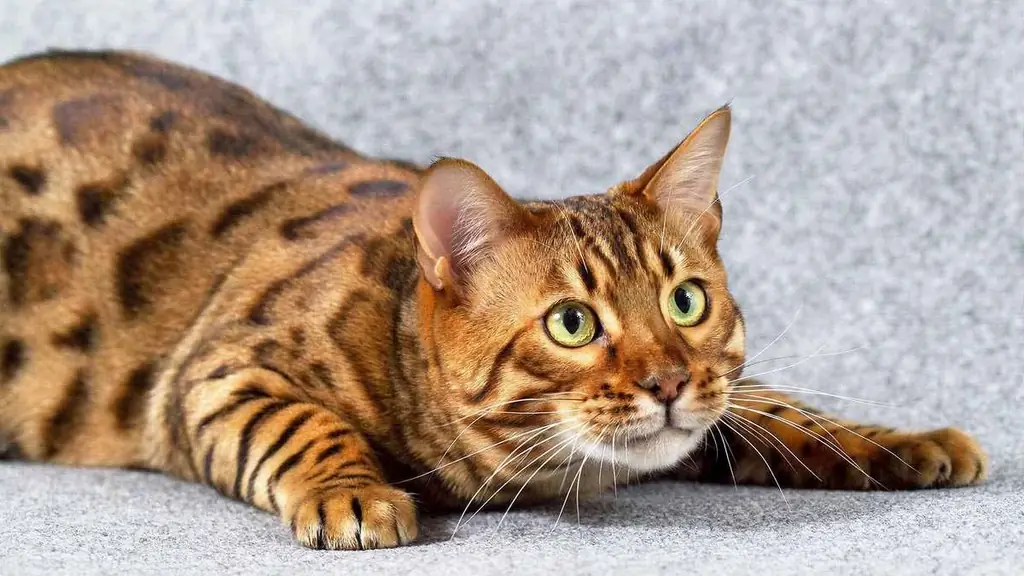
The origin of Bengal cats. External description of the breed. Features of the acquisition. The character and behavior of Bengals. The specifics of caring for a Bengal cat. Reviews
Savannah: Description Of The Cat Breed, Features Of Care And Maintenance, Photos, Reviews Of Cat Owners
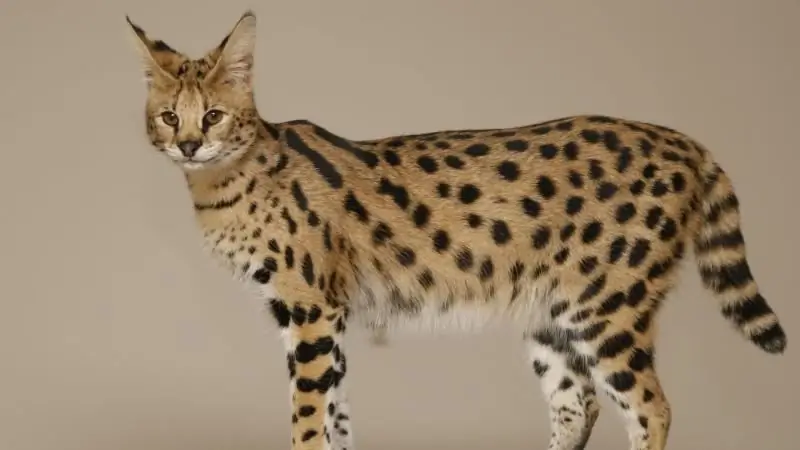
History and origin of the Savannah breed. Differences from other breeds. Features of character, upbringing and care. Choosing a kitten. Breeding animals. Reviews of the breed
Chausie: Description Of The Breed, Character And Habits Of A Houseie Cat, Photo, Choice Of A Kitten, Reviews Of Cat Owners
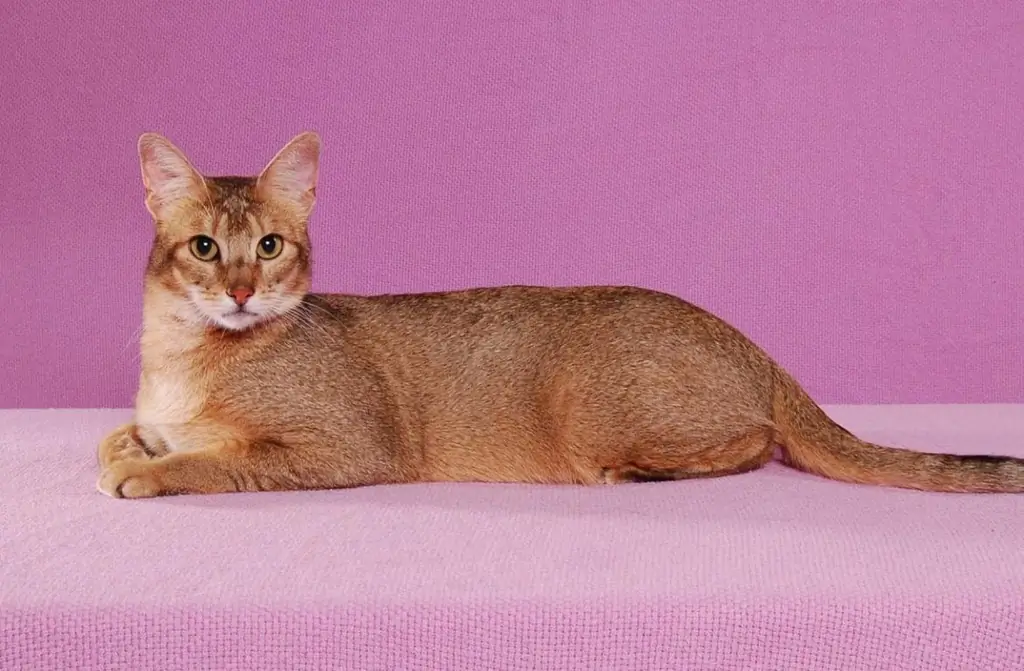
The history of the origin of Chausie. Breed standard. Character, behavior, health. Features of nutrition. Tips for choosing a Chausie kitten. How to breed. Reviews. Video
Belgian (Bengal Cat): Description Of The Breed, Character And Habits, Maintenance And Care, Owner Reviews, Photos
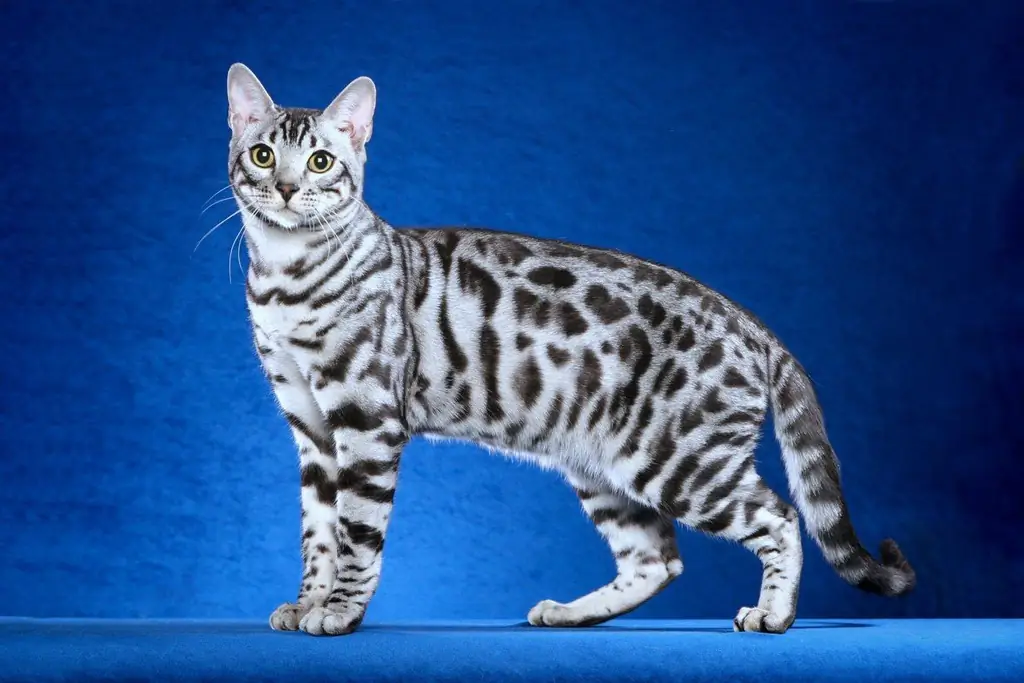
The history of the origin of the breed. The appearance of a Bengal cat. Bengal character. Health. How to take care of your pet. How to choose a kitten. Reviews
Anatolian Cat: Features Of The Breed's Appearance, Care And Maintenance Of The Cat, Character And Habits, Breeding Pets, Owner Reviews

Where the Anatolian breed is bred. The main external differences, the nature of the pet. How to properly care for him, feed him. How to choose a kitten. Breeding. Reviews
